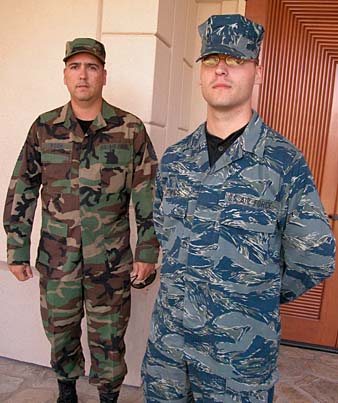
CRAIG T. KOJIMA / CKOJIMA@STARBULLETIN.COM
Robert Rosh, left, models the current green, black and brown camouflage battle dress uniform, while Mark Gonzales wears the new blue, green and gray design.
Air Force eyes
change in fatiguesA blue, green and gray
wash-and-wear uniform is being tested
Master Sgt. Kenneth Ceaser has seen two changes in the style and color of his fatigues during his 18 years in the Air Force. If he stays an extra two years, he might face a third.
This time, it's a little more colorful and controversial change, acknowledges Senior Master Sgt. Jacqueline Dean, chief of the Air Force Uniform Board.
That is because the current green, black and brown woodlawn pattern camouflage battle dress uniform, which has been used by all services over the past two decades, may be replaced with a wash-and-wear one with a tiger-striped blue, green and gray pattern.
"We're not trying to camouflage anyone because 97 percent of our career fields do not need to be camouflaged on a daily basis," said Dean, who was at Hickam Air Force Base last week to introduce the uniform change and several others to island Air Force personnel.
Dean said that when Air Force Chief of Staff Gen. John Jumper two years ago directed a search for a new fatigue uniform, he wanted something that was distinctively Air Force.
"He wanted one that fit better, was less expensive and easy to maintain," Dean added.
That meant a uniform that didn't have to be starched, which also was the goal when the green and brown camouflage battle dress uniform was introduced two decades ago, but never adhered to. The Air Force estimates home laundering will save between $180 and $240 in laundry costs a year.
Dean said 700 Air Force personnel at 20 bases began testing the distinctive uniforms two months ago. Hickam is not one of the test sites. However, three people there are modeling the new fatigues -- Command Master Chief Dave Popp; Brig. Gen. Polly Peyer, Pacific Air Forces director of logistics and the senior female officer on the base; and Col. Dave Fadock, Pacific Air Forces inspector general -- because they hold high-visibility positions.
"They (the testers) will wear it for six months, at least four days a week," Dean said. "They are supposed to keep a log on how many times they wash it and how it wears. Midway through the test we will evaluate what is being done, and at the end we will go back to some of these bases to examine the uniforms."
Dean is visiting Air Force installations showing off the changes.
"Nothing about the uniform is set in concrete," Dean told several gatherings of Hickam enlisted personnel last week. "And that is why we need to get feedback from you. Give us your feedback, whether it is positive or negative."
She said Air Force personnel will also be able to go online and express their opinions.
Airman 1st Class Mark Gonzales, a Hickam intelligence specialist, was given the opportunity to wear the uniform, which is composed of 50 percent nylon and 50 percent cotton, for two days.
"It's very lightweight," he said. "I feel like I am wearing flannel pajamas. It's very comfortable and gets us away from looking like the Army."
Dean said another feature is that the uniform will come in actual sizes. Men's pants will come in sizes 28 to 48 and the shirts will come in jacket sizes 34 to 52; women's uniforms will come in sizes 2 to 24.
"It's going to provide a much better fit," she told her Hickam audience.
The other controversial piece of the new fatigues is a proposed hat that is patterned after the one worn by Marines.
It will be up to Jumper to decide by early next year whether to field the new fatigues. It will take another two years before everyone in the Air Force is required to have them in their duffel bags. The clothing allowance for enlisted personnel will be increased to cover the costs of any mandatory changes.
The test also includes two new boots, one in suede and another that is a low-polish, low-shine black leather style. The suede boot will be tested in black, charcoal gray and tan.
Also being fielded are new physical fitness running suits, shirt and shorts; a blue pullover sweater; black three-button Henley "Cool Max" T-shirts with the Air Force logo on left breast and the wearer's name embroidered on the right; and black rigger belts and windbreakers with the Air Force log embroidered on the front. Enlisted airmen will be issued two sets of shirts and shorts and one running suit beginning in October. The rest of the items are optional.
As for Ceaser, 39, whose first set of fatigues in 1986 was dark green and had to be starched, change is good.
"I like the old BDUs," Ceaser said after attending one of Hickam's orientation sessions. "Now I like the new ones. I like change."
